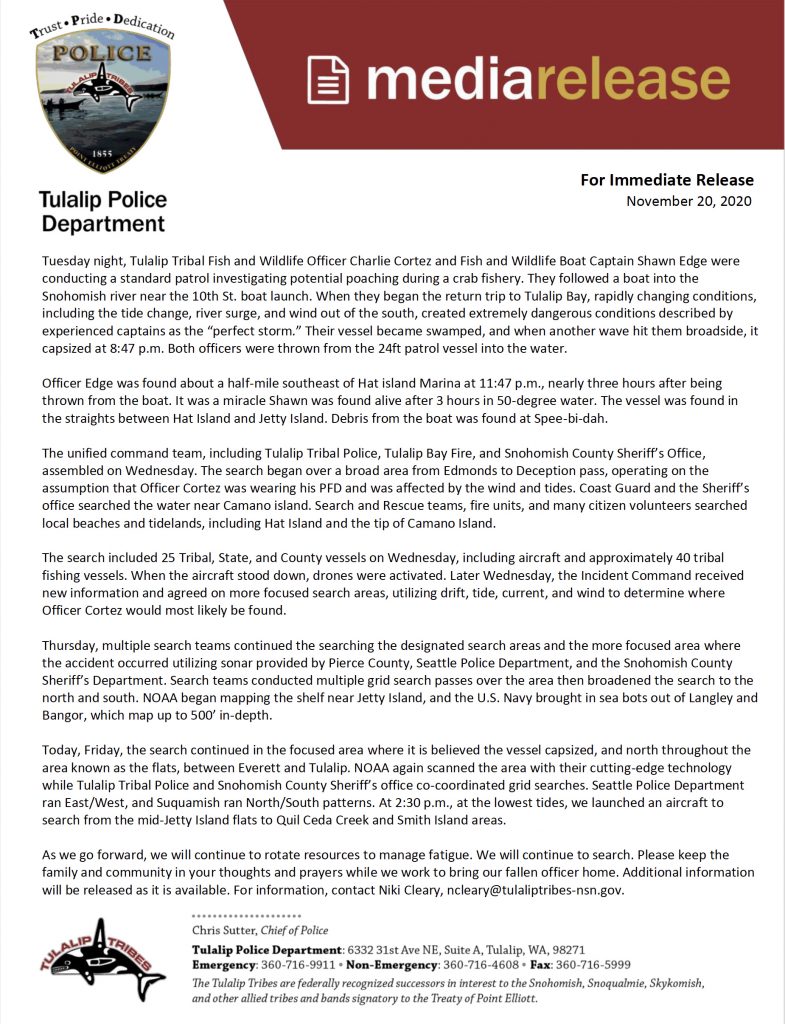
Tulalip Police Department Update

syəcəb

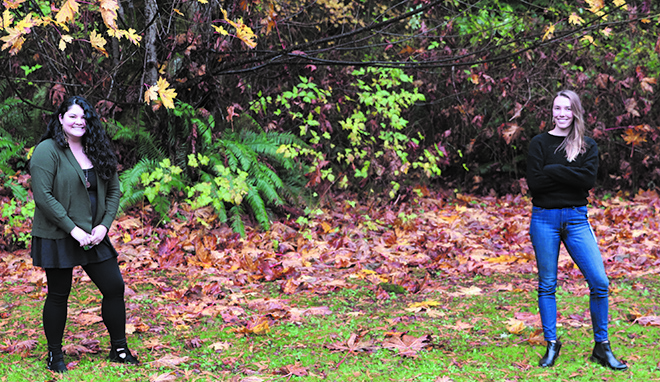
By Kalvin Valdillez, Tulalip News
Did you know that there is a program that helps with resources, education, and general support designed specifically for Tulalip tribal families living with children? If not, you’re not alone as the program is still relatively new. A division of beda?chelh, the young program is spreading the word about their services and what they can offer Tribal families.
Stated beda?chelh manager, Natasha Fryberg, “I want to bring forth our FIT team to start getting more resources out in the community so we can create positive engagement with potential clients and families.”
The Family Intervention Team, or FIT, currently consists of two social workers, Lena Hoeflich and Kayleigh Canby, who are dedicated to aiding Tulalip families by helping them along their journey through tough times. Whether you are a single pregnant mother or a family dealing with a rebellious teen, they are available and ready to help support you and provide any services or needs you may require.
“I always describe it to clients as a voluntary program,” said Kayleigh. “Our goal is to kind of bolster the family, or bring in supports, to help them be successful in whatever they want to do. Usually, the goal is to try and keep their families together and we bring in those supports to help them be successful. We support parents, we support children, we support everybody.”
The FIT mission is to achieve immediate and lasting positive change for families, in the best interest of the children, whether you live on or off the reservation. FIT makes it their priority to see that you receive assistance and will refer you to a program, professional or specialist who will provide you with further care.
Lena explains, “We try to bridge a gap that a family might be experiencing, a hardship – whatever that may be. We meet with families and it is family-led. It’s not prescriptive, because it just depends on whatever the family needs, and whatever they’re going through at that time. For example, if someone calls and says this person was driving and their kid wasn’t in a car seat, we can come in and ask if we can educate them on the necessity of a car seat. Can we provide them with a car seat? We can ask, what else do they need? Do they need groceries? Do they need help paying bills? Do their kids need assistance being set up in online schooling?”
Some resources and services that FIT assists families with include parenting skills, housing, food and nutrition, domestic violence, independent living skills, chemical dependency, teen support and mental health.
“If a family is experiencing a really difficult time with their teenager, we work with them and get them set-up with Family Haven. We will work with them before, during, and after they have those intervention services, just to make sure that everything is continuing to go well. Or we might work with families who may have difficulty paying a bill. We look to see if there are resources within the Tribe or within the state or Snohomish County, just to try to find different ways to help,” said Lena.
Kayleigh added, “I have a mom that I’m working with right now and I’m trying to help her find a mental health counselor. At the same time, I reached out to a couple different agencies locally, she’s a pregnant mom, so she needs a bed to sleep on. We do the legwork of trying to find those materials. I have another family and their children are in need of winter clothes, so we find those resources in the community to get warm clothes for those kids.”
The majority of clients and families that FIT has helped so far are referrals from Child Protective Services. However, FIT wishes to assure Tribal members that they are here for the people, and welcome any community-referred and self-referred clients. Although they are an extension of beda?chelh, their focus is to work with clients and take preventive measures and progressive steps to help keep families together.
“A lot of families have a huge support network, but there are other individuals who don’t have any support networks at all,” Kayleigh expressed. “We’re here to help support them, we are apart from CPS. We are a voluntary program, we’re not going to hunt you down or tell you what to do. I think that’s the biggest message is that we’re just here to help, we’re here to raise-up the community in the ways that they want.”
Lena agreed, saying, “I think that’s a distinction that we’re trying hard to make people understand, because when we do call and say we’re a new program with beda?chelh, that usually closes the door immediately. We’re very different. The whole point of our program is to prevent families from having interventions or any interaction, really, with CPS or the court systems. We’ll work with any family who we think would be a good ‘fit’ in the program.”
For additional information about the Family Intervention Team, please contact (360) 716-3284.
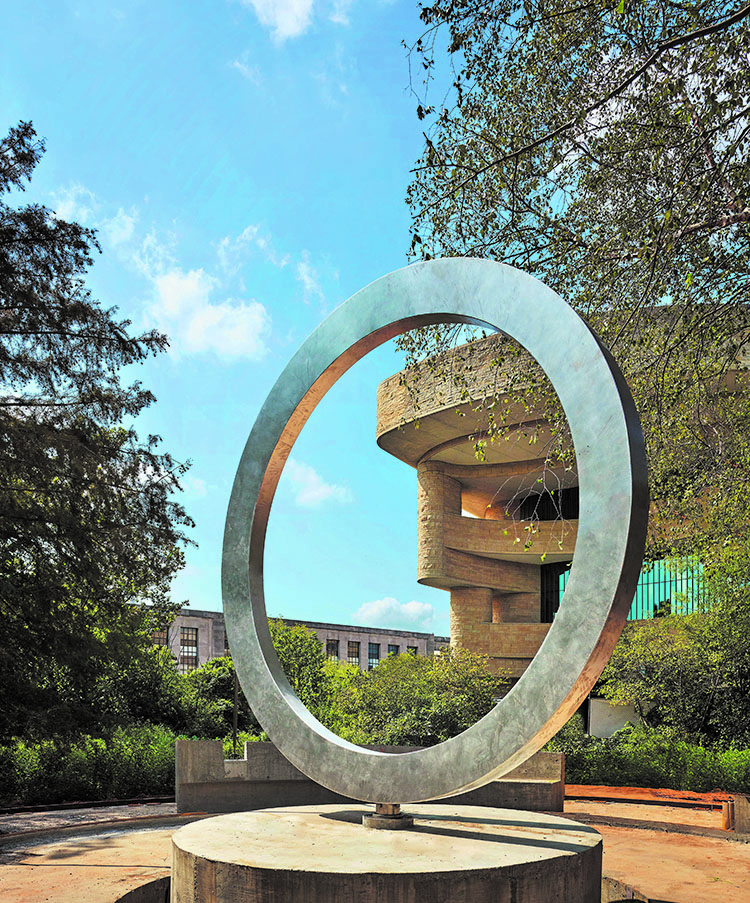
By Micheal Rios, photos courtesy of Alan Karchmer for NMAI
A permanent memorial dedicated to generations of Native American military veterans was unveiled on Veteran’s Day, November 11, in the heart of Washington D.C. It’s been over twenty-five years in the making, as Congress authorized construction of such a dedication in front of the National Museum of the American Indian back in 1994.
To celebrate the momentous occasion in the age of COVID-based restrictions and social distancing, a planned dedication ceremony and veterans procession was replaced with a virtual program. Opening the video presentation was none other than Tulalip’s own Board of Director and Army veteran, Mel Sheldon.
“I’d like to start by thanking our elders and veterans. All the brave men and women who have served before us created the foundation for our next generation,” said Mel during the initial moments of the twenty-two minute program. “They created a legacy that extends to the younger leaders of our country, as well as those who are now currently serving in the armed forces.
“My father was a Marine and he served in World War II. His example led me to carrying on that proud tradition when, at just 19-years-old, I served in Vietnam as a helicopter pilot,” he continued. “Here at Tulalip, we have a number of women who have served in the military and in our traditional way we raise our hands to them for their courage and service. There have been 29 million people serving in the U.S. military from World War I to Iraq and Afghanistan, and a good portion of them are proud Native Americans. [We] have served at a very high rate in the military and we’re very proud of that warrior tradition.”
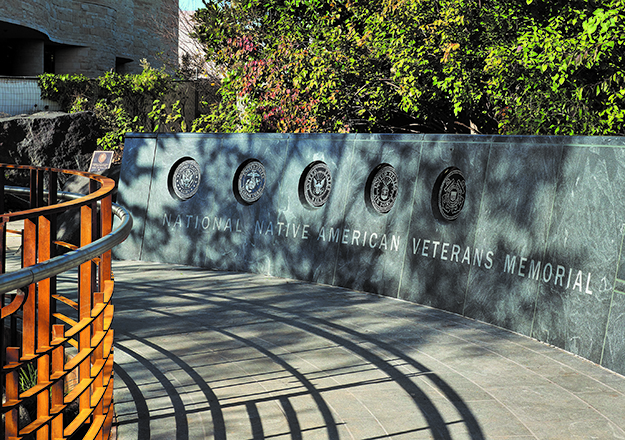
Native men and women have always been defenders of their lives, traditional homelands, and cultural lifeways. The call to serve in the United States military has been strong for our people since the nation’s founding, long before being officially recognized as U.S. citizens in 1924.
In fact, the Department of Defense recognizes that today’s military successes depend heavily on the contribution of America’s first people. Thirty-one thousand proud Native American men and women are on active duty today, serving in Iraq, Afghanistan, and elsewhere around the world. In total there are 140,000+ Native veterans living, breathing, and passing on teachings about honor and duty to a cause much larger than oneself.
The best stat of all is as a demographic, Native Americans serve in the armed forces at five times the national average and enlist in the military at the highest per-capita rate of any other group. A longstanding warrior tradition of so many, past and present, is now forever memorialized with a federal monument in the U.S. capital.
Designed by multimedia artist and Marine Corps veteran, Harvey Pratt (Cheyenne and Arapaho), the one-of-kind fixture features an elevated stainless steel circle resting on a carved stone drum. It also incorporates water for sacred ceremonies, benches for gathering, and four lances where veterans, family members, tribal leaders and others can attach prayer ties for healing.
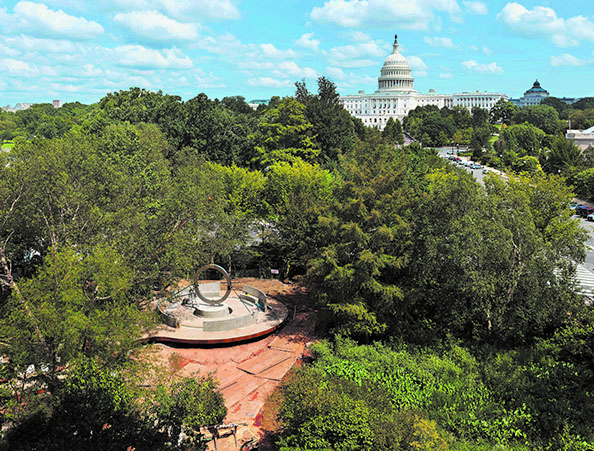
“That big vertical circle that stands in the middle, I call it the hole in the sky where the Creator lives. When you pray, that prayer goes through there and the Creator receives it and blesses you,” explained Harvey in an interview with Indian Country Today. “No matter how you feel about how our country has treated Native people, it’s important to honor all our Native warriors. They fought to protect the land we live on. That’s what warriors do.”
While the warrior mentality to protect the sacred has a long and prideful history, at the same time Native communities have never taken a loss of life lightly. Paying homage to fallen warriors as heroes with reverent memorials filled with ceremonies and prayers is a traditional teaching that unites tribal members of all 574 federally recognized tribes. Dubbed the Warriors’ Circle of Honor, this memorial intends to unite any and all visitors though a connection of service and sacrifice by Native veterans, past and present.
“The National Native American Veterans Memorial will serve as a reminder to the nation and the world of the service and sacrifice of Native American veterans,” said Kevin Gover (Pawnee), NMAI director. “Native Americans have always answered the call to serve, and this memorial is a fitting tribute to their patriotism and deep commitment to this country.”
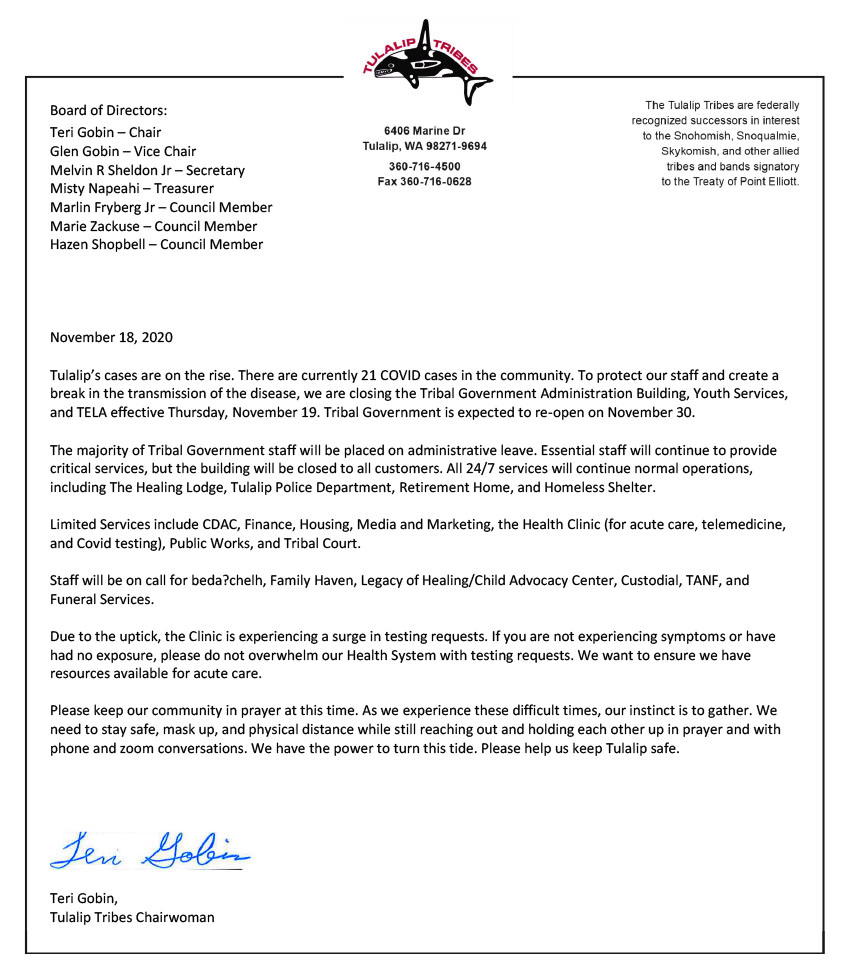

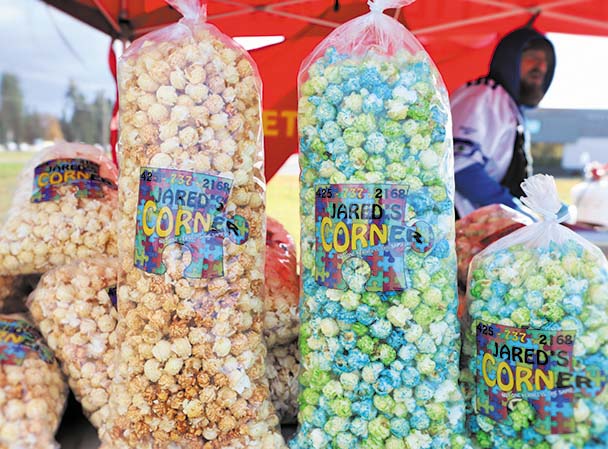
By Micheal Rios, Tulalip News
Kettle corn has been described as the perfect snack. Its unique combination of sweet and salty, with just the right amount of crunch, is a highly sought after mouthgasm at fairs and outdoor festivals by people of all ages. For one Tulalip family, kettle corn represents something much more significant than an occasional treat, it represents a voice for the voiceless.
“Our youngest son Jared has autism. He was put on the spectrum when he was a toddler,” explained former Board of Director, Jared Parks. “As a family of eight, it’s been an adjustment for us all. We’ve learned so much about autism and how it’s a spectrum, which means that it effects people differently. For our son, he has nonverbal autism. He may not be able to speak, but he can still express himself.”
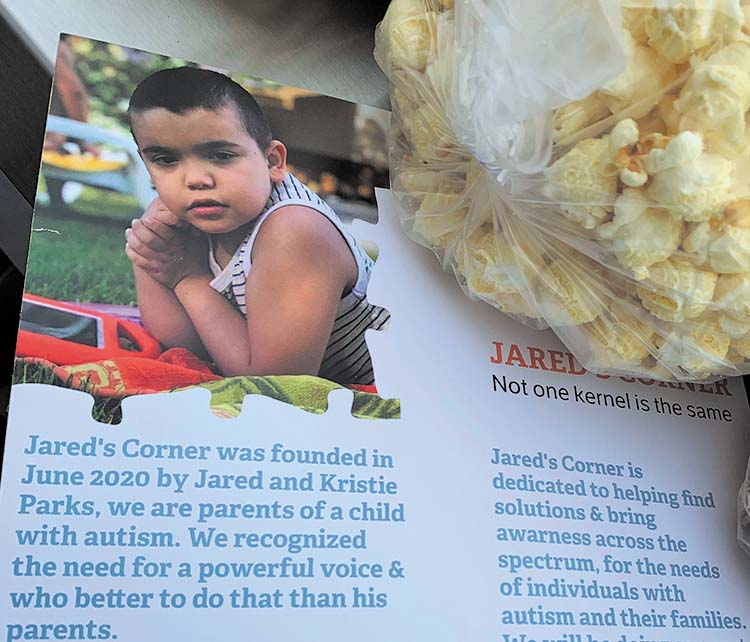
That expression is clearly evident when 7-year-old Jared II is around kettle corn. His parents say “he lights up and has a grin from ear to ear”. Young Jared’s love for flavorful popped kernels was the inspiration behind his parents’ decision to create a small business venture named after their son, called Jared’s Corner. Their mission? To help raise awareness about autism spectrum disorder.
Autism impacts people regardless of race, ethnicity, socioeconomic status or political allegiances. It is estimated that 25 million people are affected worldwide. There is no cure for autism, and currently boys are approximately 4.5 times more likely to receive an autism diagnosis than girls. Often not discussed is the high rate of autistic individuals who are nonverbal, which is true in roughly one-third of all cases.
“I had to throw out the parenting book with all I knew and needed to learn new ways to communicate and show affection,” shared momma bear, Kristie Parks. “It’s been challenging. I tell my kids all the time ‘I love you’ and they say it back to me, but my son can’t. He’s never called me ‘mom’, or been able to tell me if his tummy hurts or if someone hurt him. What my son has become is my family’s biggest teacher. He’s taught us to slow down our lives, be extremely patient, and accept all of life’s blessings.”

According to the Centers for Disease Control (CDC), nearly 1 in 54 children have been identified with autism. That’s nearly twice the rate from 1 in 125 found in 2004. The dramatic increase and recent spotlight shining on the developmental disorder has opened opportunities for the nation to consider how to serve people on the autism spectrum and their families.
“Our son is different from our other five kids in so many ways, but we really do view it as a blessing,” added Jared. “He’s taught us to be better parents. We’re more patient and compassionate because of our son. Now, we want to spread awareness about autism and it just so happens kettle corn is a good metaphor for the spectrum.
“Basically, we can take a batch of this kettle corn, lay it out, and see that no two kernels are the same,” he continued. “They are all different, just like those on the spectrum. That’s the meaning behind our slogan, ‘not one kernel is the same’.”
By founding Jared’s Corner this past summer, parents Jared and Kristie intend to speak on behalf of their son to customers who stop by their stand to purchase a bag of freshly popped kettle corn. While completing their transactions, customers are informed of Jared’s Corner’s namesake and the meaning behind the logo.
The puzzle piece is a highly recognized symbol for autism spectrum disorder. It symbolizes all the different ways individual kids fit together. It symbolizes the complicated ways this disorder may manifest itself in children. It also symbolizes how there is no one therapy that works for everyone, and sometimes it’s a whole puzzle of therapies that when pieced together just right actually make a difference.
The Parks family is dedicated to helping find solutions and bring further awareness across the spectrum to the needs of individuals with autism and their families. They will be doing their part by donating a percentage of annual income to pro-autism foundations.
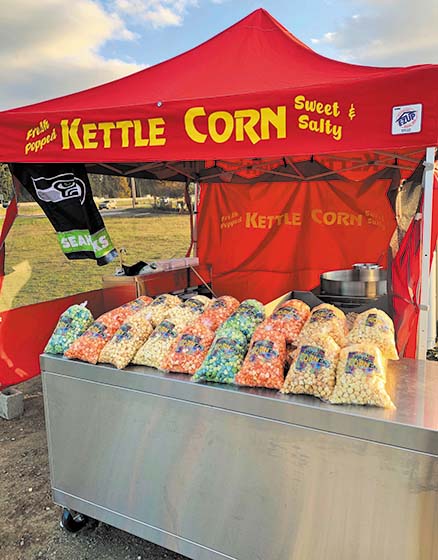
“Being baby Jared’s mother, his voice, his protector, it was and still is an unbelievable roller coaster ride,” said Kristie. “We want to share our experience because the autism rate continues to go up and there is so little information available to parents and families who struggle in silence. Our goal with Jared’s Corner is to help promote understanding that just like ‘not one kernel is the same’, every child is different and every autism story is different.”
Jared’s Corner is conveniently located on the Tulalip Reservation along Quil Ceda Boulevard, in the vacant lot between Cabela’s and Home Depot. They are open for business Thursday – Saturday from 10:00am – 5:00pm. Other locations and times to come, such as outside Tulalip Market and Remedy. Keep a look out for the red pinched tent or follow Jared Parks on Facebook for details.
Regular kettle and caramel kettle are always available in medium ($5 bag) and large ($10 bag). A third flavor is offered as well, which ranges from cinnamon toast, chocolate, vanilla, orange and grape. Because this is the Pacific Northwest, aka Seahawks Territory, every ‘blue Friday’ a mixed batch of green apple and blue raspberry is available.
Jared’s Corner can also provide kettle corn for private parties and events. For more information or to place an order to support a wonderful cause, please call (425) 737-2168.
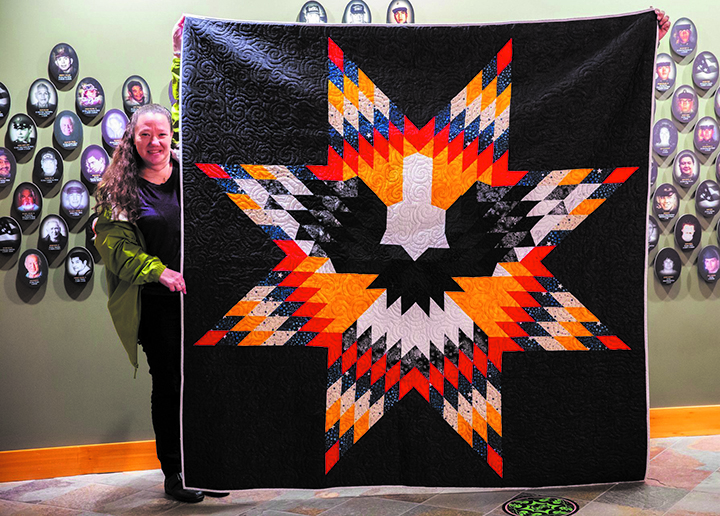
By Kalvin Valdillez, Tulalip News
“Oh, how gorgeous,” exclaimed Misty Napeahi, Tulalip Board of Director.
“So beautiful, that took a lot of hard work,” added Tulalip Chairwoman, Teri Gobin, as a handmade quilt, crafted with extra love, was gifted to Mel Sheldon, BOD member and Vietnam Veteran, on the morning of Friday November, 6. Overcome with surprise and emotion, Mel thanked the designer, Sheila Hillaire, for her work while still entertaining the room in true Mel fashion, causing fellow board members to chuckle as he received the honoring.
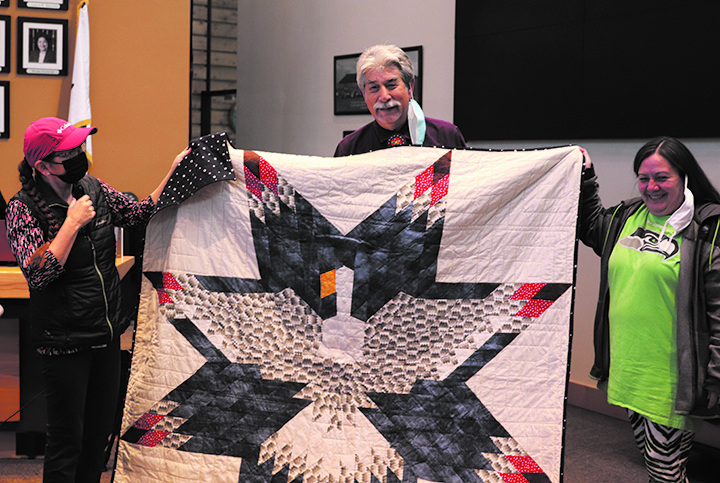
A group of Tulalip women have dedicated their time and energy to a venture that warms the hearts of many, and often brings overwhelming tears of joy to Tulalip veterans and their families. The Veterans Quilt Project was founded in 2016 and since then approximately thirty-five quilts have been gifted over the years, honoring service men and women of all military branches. Each Fall, the ladies decide on a pattern and create one quilt each for the Tulalip Veterans.
Sheila explained, “As a group we chose what pattern to use when we got together in October last year, pre-COVID, and started working on it. I actually had the star done that weekend, everything else took me a bit longer and I finished in July. I knew it was going to Mel and we are related, so it was really special to me. It felt great to be able to personally hand it to him. This is my second year participating in the quilting project. The first quilt I did went to my father John McCoy, it just so happened that he was receiving the first year I did the program.”
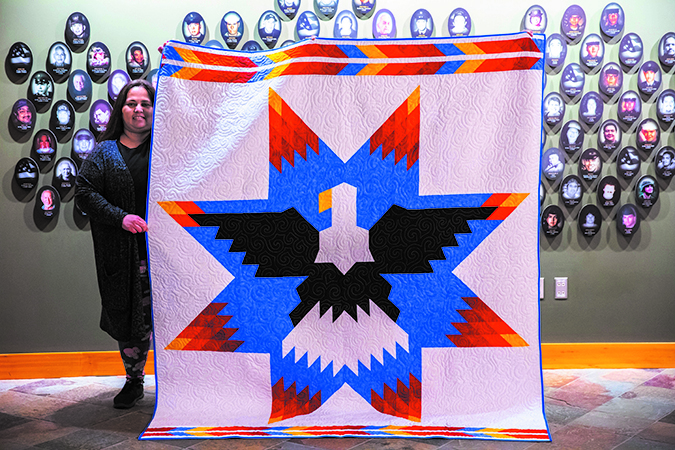
Normally, the quilts are gifted to the veterans at the Hibulb Cultural Center’s yearly Veterans Day event. Due to the pandemic, the ladies opted to hand-deliver this year’s quilts to the veterans, continuing the tradition after the cancelation of the museum’s annual celebration. Like Mel, seven additional Tulalip vets were caught off-guard as an unbeknownst and impromptu blanketing ceremony took place in their honor, most likely on their front doorsteps.
The Veterans Quilt Project has received partial funding from the Tribe’s non-profit organization, The Tulalip Foundation, since its beginning and the ladies raise the remainder of the costs for materials by way of fundraisers throughout the year.
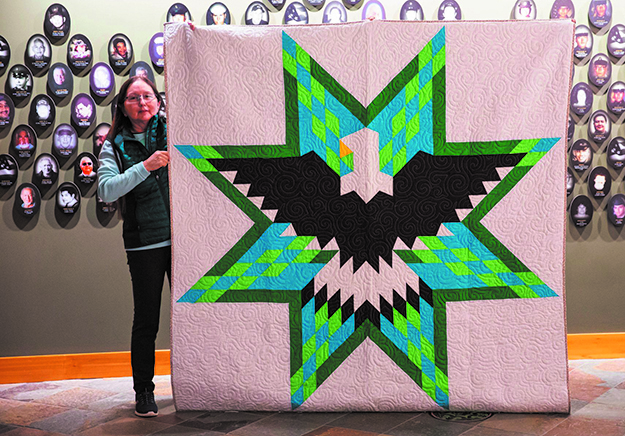
Said the Foundation’s Executive Director, Nicole Sieminski, “We love supporting community driven projects. It’s always great to see the amazing work these ladies do and it’s such a great opportunity to support our veterans.”
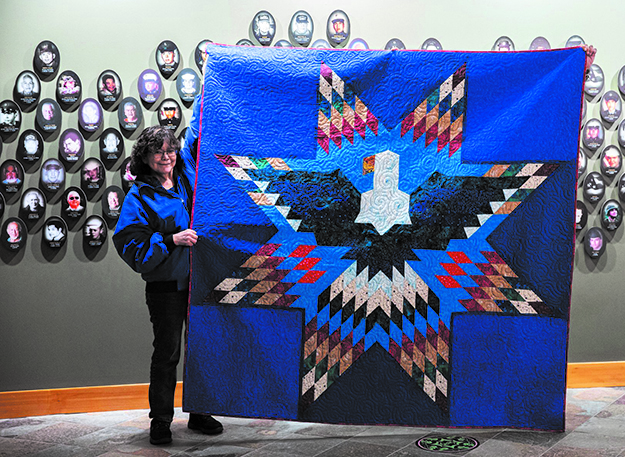
The list below names the quilters as well as the veterans who they designed this year’s quilts for:
After providing smiles and a personal thank-you to the Tulalip Veterans, the ladies are excited and already planning for next year’s project.
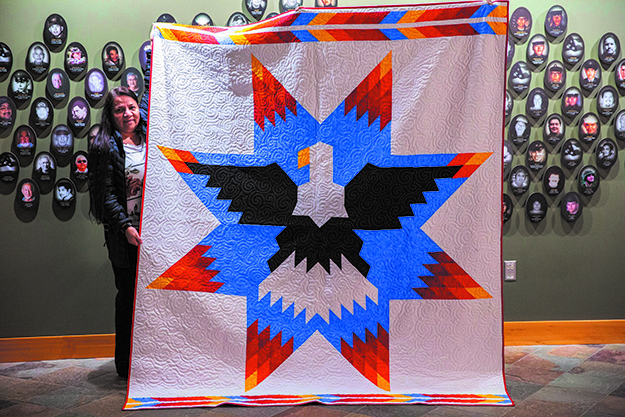
“We enjoy doing this work and giving back to our community, making sure our veterans are recognized for protecting us and our country,” expressed quilter and Project founder, Rae Anne Gobin. “Each one of us took the time to select our fabric and put our love in each of these quilts. We hope each recipient finds the quilt comforting. We know our veterans put their lives on hold while serving, and helped protect us to keep our freedom. We care for and love our Tulalip veterans and want to honor them for their service and let them know, you are not forgotten and will always be remembered.”
By Kalvin Valdillez, Tulalip News
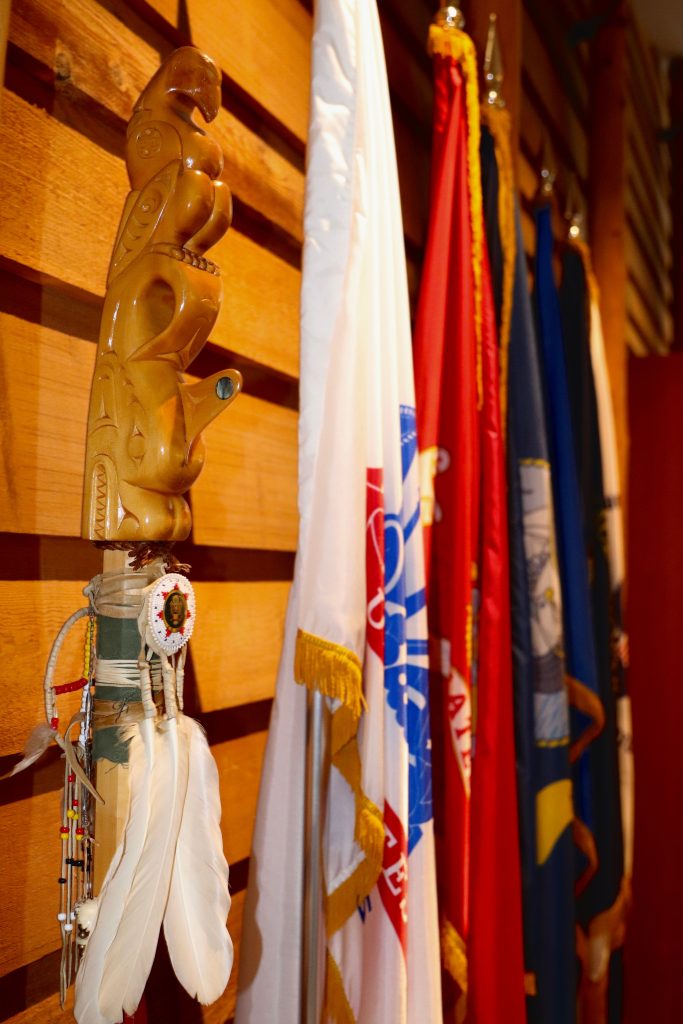
The coronavirus has put a halt to many local events, ceremonies and traditions that occur annually at Tulalip. In some instances, events were canceled entirely to limit the spread of the disease on the reservation. Other times, throughout the year, programs modified their events so they can continue offering their services to the people in a responsible manner.
After months of closure, the Hibulb Cultural Center (HCC) re-opened their doors to the public in August. Since then, they have safely offered a space for people to learn about Tulalip culture, while re-introducing a sense of normalcy during a time of unknown. Thanks to modern technology and a dedicated fanbase, HCC held their annual Film Festival, that would have otherwise been canceled due to gathering limitations.
The same cannot be said for all events, however. For the well-being and betterment of the community, HCC has declared that the always popular Veterans Day Celebration will not take place this year.
Before COVID-19, HCC held an honoring in observance of Veterans Day. Every November 11th, Tulalip veterans and their loved ones gathered in the museum’s longhouse where memories were shared and tears were shed for the fallen soldiers and those veterans who are no longer with us.
A particularly moving moment during the event is Roll Call, when each veteran states their name and which military branch they served. Family members of veterans who passed speak their names aloud in remembrance, highlighting their dedication to protecting the country and their people. The event typically ends with a special gifting, when the ladies of the Veteran Quilt Project blanket and thank a select group of vets for their service with a beautiful, handmade-with-love quilt.
Although the 2020 Veterans Day gathering has been officially nixed, HCC is still observing the holiday and paying tribute to the veterans of Tulalip and the community.
HCC Museum Manger Mytyl Hernandez explains, “This year looks a lot different for us on Veterans Day. In the past, we’ve been privileged to host a large celebration and honor all of the veterans in our community. Since we are not able to gather in the same way, we are still offering free admission to all veterans, active military, and their families on Wednesday, November 11, in honor of Veterans Day. We will be open 10 AM to 5 PM.”
The free admission of course includes access to the many displays which pay respect to Tulalip veterans of the United States Military. These displays include a tribute to Tulalip Gold Star Mothers, whose children never returned home from combat, as well as the Veterans Gallery which showcases a photo of each Tribal veteran, categorized by which war they served in such as WWI, WWII, Vietnam, Korea, Afghanistan and Iraq. The Veterans Gallery is quite popular amongst Tribal youth, who excitedly identify their family members who served. A number of personal items that returned home from war are also on display in the halls of the museum like Mel Sheldon’s combat helmet and Sam Wold Jr.’s service medals and uniform.
If you are interested in learning more about Tulalip veterans and wanting to observe the holiday safely, drop by the HCC museum on Veterans Day and remember admission is free to those who served, are currently serving, as well as to the family members of veterans and active duty service men and women.
“It is always a privilege to spend time paying tribute to our veterans at the museum,” Mytyl expressed. “No matter the day, it is always important to honor our veterans. They gave up so much for each and every one of us to have individual freedoms. They sacrificed so that we didn’t have to. I am always grateful to the veterans in our community and I will personally miss spending the day with our veterans. It is always my favorite event of the year and a day that my children look forward to volunteering at.”
For more information, please visit the Hibulb Cultural Center’s Facebook page, website, or dial (360) 716-2600. And be sure to extend a thank you to those warriors who bravely defended our freedom.
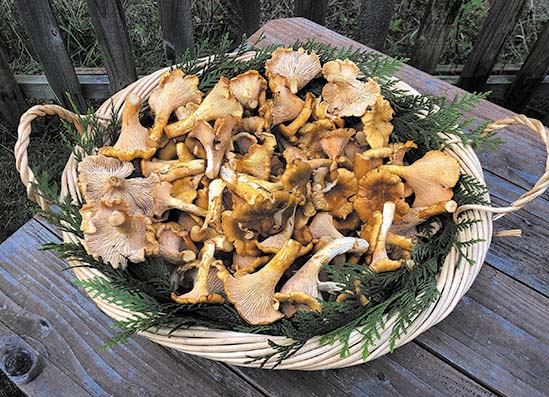
Submitted by AnneCherise Jensen
People from many cultures have a long history of gathering mushrooms for food, medicine, dyes, clothing and decoration. Over the centuries, humans have accumulated a considerable amount of knowledge about mushrooms, whether they be poisonous, edible or medicinal species. However, because of their variety of health effects, many people have steered away from incorporating wild mushrooms and other fungi into their diet.
Mushrooms are a common, and plentiful wild edibles that grows naturally in the Pacific Northwest. If we have the proper tools, hands on experience, education and resources, we can easily identify and locate some edible species and incorporate them into our diet. This article will dive deeper into some common variations of local, edible mushrooms, their health properties, and how to incorporate them into meals in the kitchen. Let’s get started!
Did you know that there are over 2,000 varieties of edible mushrooms? In fact, there are actually more species of edible mushrooms than poisonous mushrooms. Most poisonous mushrooms won’t kill you, side effects usually include upset stomach, vomiting and/or food poisoning symptoms. Some common poisonous mushrooms grown in the PNW include Sulfur Tufts and certain types of Amanitas. Keep in mind, poisonous mushrooms are only harmful when eaten. The harmful toxins they contain cannot penetrate the skin, and won’t harm you if touched, only digested. Make sure to always cross reference a species before consuming.
Edible mushrooms are tasty, nutritious and can be used in a wide variety of dishes. Mushrooms contain the 5th flavor called umami, which is also known as savory and having a meat-like taste and texture. In fact, mushrooms can often be used as a meat substitute in the kitchen. Foraging for local mushrooms is an economical and nutritious way to enhance meals at home (they’re free). There are thousands of nutrient dense mushrooms in the forest just waiting to be eaten. The best part is the more you forage wild mushrooms, the more abundant they grow the following year. Here are some tips to help you on your next mushroom forage.
Mushroom Foraging Tips:
Common species of locally foraged, edible mushrooms:
There are over 100 species of edible mushrooms that are common in the Pacific Northwest region. Some species are rarer and some are generally easier to find. Here are five common wild mushrooms I’ve personally identified and located in our region, starting from most common to least common.
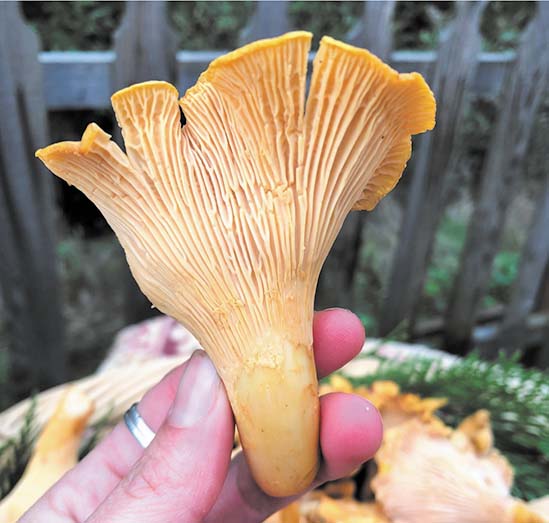
Chanterelles: Chanterelles rank among the most popular edible wild mushrooms. Chanterelles are usually vase or trumpet-shaped mushrooms with wavy-like gills. This mushroom has a fruity, apricot-like aroma and mild, peppery taste. Most are yellow or orange. In its healthiest form, this is a very firm & rigid mushroom, don’t harvest if mushy or gooey.

King Bolete: There are about 20 different types of Boletes that grow in the Pacific Northwest. They contain spores underneath their caps, and are usually very spongy. Most Boletes are edible, but vary in flavor. The King Bolete is one of the most common edible Boletes in this region. They are medium to large in size, caps are usually yellow-brown, red-brown, or dark red. This is the largest Bolete and is usually pretty easy to identify.
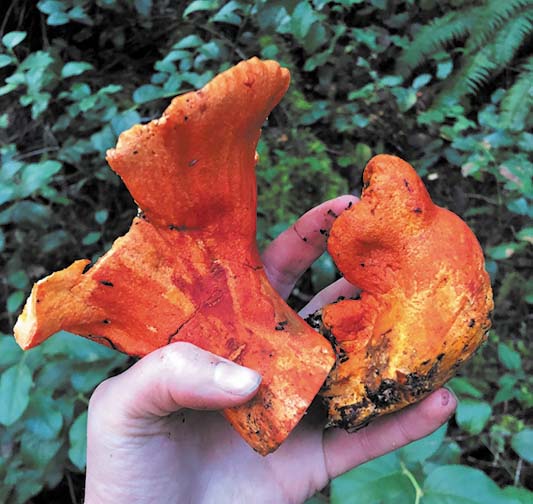
Lobster Mushrooms: Medium to large sized mushroom, in a layer of bright orange to vibrant red tissues, usually shaped like an upside down pyramid. Found in woods, especially under conifer trees in the Pacific Northwest. Lots of flavor and considered a high quality edible. With its unique vibrant red colors, this mushroom is one of the easiest to identify.
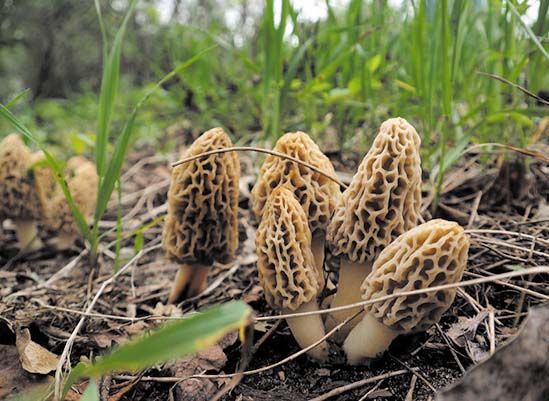
Morel: Morels have a distinctive honeycomb-like shape and vary in color from light yellow to dark brown. They are earthy in flavor and should be cooked before eating. However, these are usually only harvested in the spring months in recent forest burn areas.
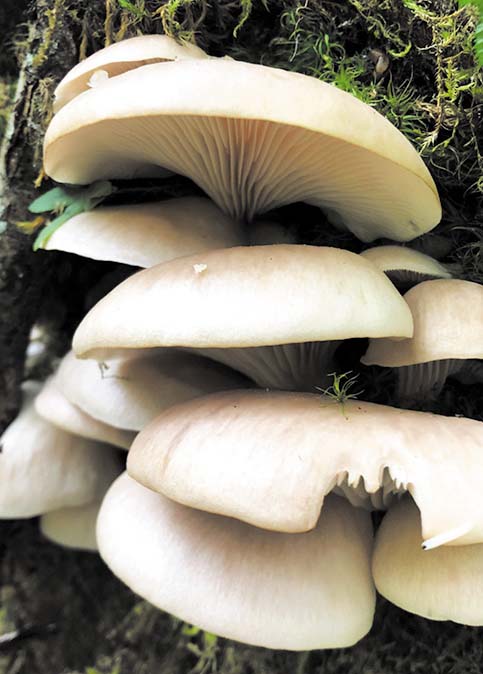
Oyster Mushroom: Oyster mushrooms are usually white, light grey or light yellow. They are smooth, trumpet-shaped that grow in clusters and have a light flavor. There are a few species of oyster mushrooms. All are edible but vary in flavor, color and shape.
Mushroom Identification Resources: Below are some mushroom identification books that I use frequently. There are others out there, but these are just a few that I’ve used. I find it helpful to use books that are specific to your area. Mushrooms of the PNW is probably my most used and helpful book. Check your local bookstore or find these off Amazon.
Nutrition Properties
“One cup of raw sliced mushrooms has approximately 20 calories and are a good source of potassium and, depending on the variety, can provide selenium and copper. Mushrooms have significant amounts of three B-complex vitamins: riboflavin, niacin and pantothenic acid. The B vitamins help release energy from the fat, protein and carbohydrates in food. They also can be excellent sources of vitamin D if they have been exposed to ultraviolet light right before or after harvesting”. (Wolfram)
Cooking & Consuming
Mushrooms provide a wide range of flavors and opportunity in the kitchen. However, when first starting to eat wild edible mushrooms, it’s best to start by eating them in small portions. Some individuals have a hard time digesting wild mushrooms and get a mild upset stomach at first. The best way to overcome this, is to start with small portions and gradually eat more wild mushrooms as you get more comfortable with them. A suggestion to those who pick a mushroom variety for the first time – have an adult cook and taste a small amount of the mushroom first, and wait 24 hours to be sure there is no reaction, before making a large portion to serve to family, especially kids. When cooking, make sure the mushrooms are fully cooked, usually about 10-20 minutes of frying, steaming, sautéing, or baking will cook them thoroughly.
Sources:
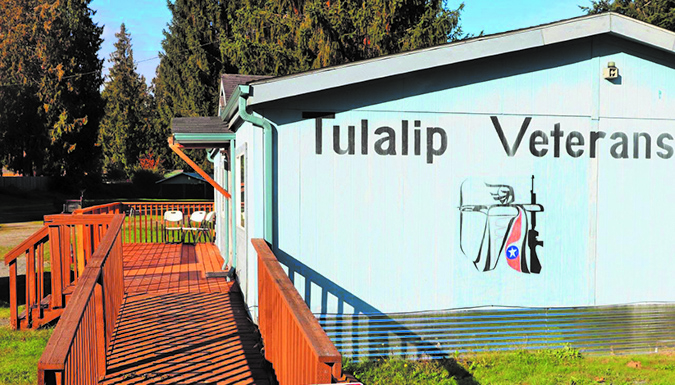
By Micheal Rios, Tulalip News
The 3rd & Goal Foundation was founded in 2011 by Notre Dame graduate and former NFL quarterback, Brady Quinn. His father served as a Marine in the Vietnam War and his grandfather fought in World War II, which inspired Brady’s desire to give back to the often neglected needs of America’s military veterans.
According to their website, the 3rd & Goal Foundation began building wheelchair ramps, as well as, remodeling bathrooms and kitchens for those veterans who were wounded to help them adjust a little easier to their new life and surroundings. Years later, 3rd & Goal began to expand its efforts to be able to serve more veterans in need by implementing Operation Education and Operation Joy components to their mission. While the mission is still growing, one thing that will always stay the same is that 3rd & Goal is committed to making a difference in the lives of our honored veterans.
This past summer 3rd & Goal supporter Tom Hoban, who grew up in the Tulalip community, had a timely conversation with Board of Director Mel Sheldon. During their chat, Mel mentioned how the reservation-based Veteran’s building was in need of repairs. Hoban immediately brought up 3rd & Goal as a viable solution. After some coordination between Hoban, 3rd & Goal, and then Tulalip Veterans coordinator Rocky Renecker, a mutually agreed upon idea to replace the aging and hazardous deck of the Veteran’s office with a new one was put into place.
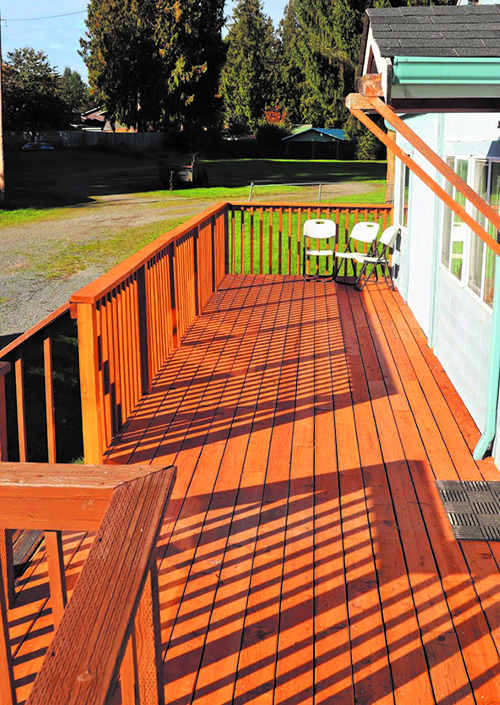
“This office is intended for all Tulalip veterans, so by replacing our old and withered deck it feels like a genuine gift for every single one of veterans,” said Veterans Department manager William McLean III. “Staff from 3rd & Goal came out periodically over the last several months, while most of Tulalip was furloughed, and built us an upgraded deck. It was must needed.
“Prior to COVID, we were having monthly gatherings for veterans,” he continued. “We were hosting those meetings at Admin because upwards of 30 people would show up and we lacked the capacity. Now with our new deck, which is twice the size of our previous one, we are able to host future monthly gatherings at the Veterans office.”
The expanded deck with improved stairs and accessible ramp makes it easier for our veterans to access their building, gather comfortably outside when they want to, and revel in the knowledge that they are not forgotten. Foundations like 3rd & Goal and individuals such as Brady Quinn and Tom Hoban are intentional with their desire to positively impact the lives of retired military servicemen.
With operation build a new deck now completed, it marks the first-ever project by 3rd & Goal accomplished in Indian Country.
“Having a group of people willing to give back to veterans for nothing more than a thank you is always great to see,” added McLean. “When our building looks nice and is maintained, it lets our veterans know they are cared for and prioritized.”
“[A huge] thank you to 3rd & Goal for everything they’ve done,” added Tulalip veteran Rocky Renecker. “Ninety percent of our Tulalip veterans are over sixty-years-old and this new accessible space will make it possible for us to come together as a veteran community.”